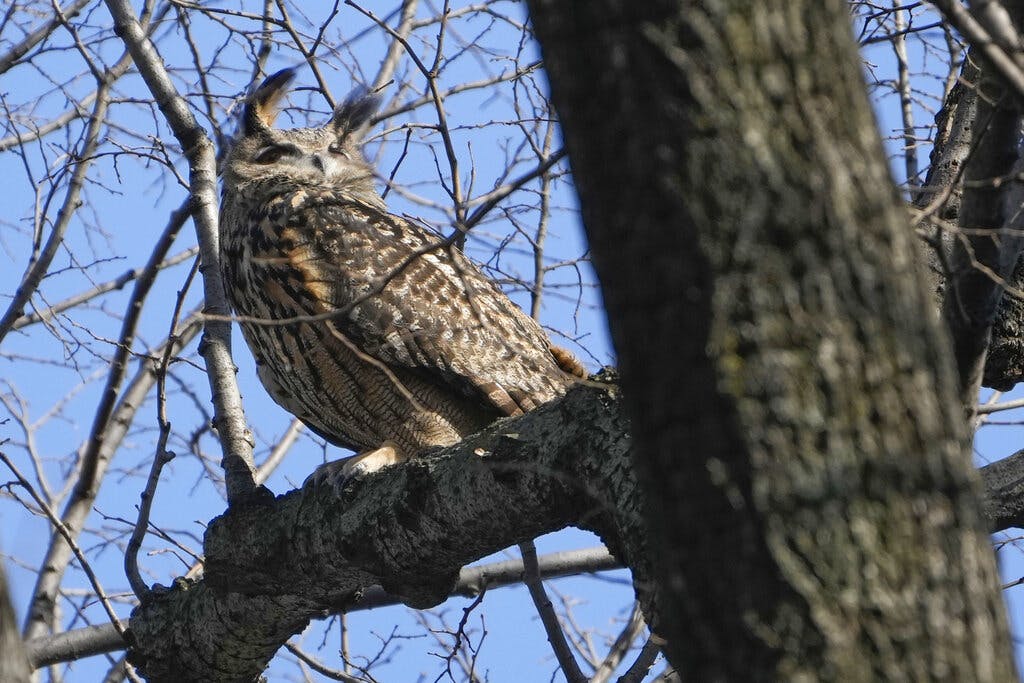Flaco the Owl Shows the Way for Helicopter Parents — and Zookeepers
The experts feared he couldn’t survive on his own and desperately tried to make him come home. Yet Flaco was born to fly.

Meet Flaco, the “Free-Range Kid” … who happens to be an owl.
At age 13, having spent almost his entire life in the Central Park Zoo where he was pampered, loved and educated (his home had a mural), this Eurasian eagle-owl was suddenly sprung from his cushy confines the night of February 2.
Someone — not me! — cut a hole in his wire mesh cage and out Flaco flew, into New York history.
Or at least, Central Park.
His helicopter parents — er, zookeepers — desperately tried to make him come home. Their owl was not ready for the real world. It’s dangerous out there, they warned. Winter. Windows. Predators.
Never mind that Flaco IS a predator.
So, the zoo folks baited traps. They played Eurasian eagle-owl sounds. They did everything but promise him a trip to Disneyland and a TikTok account with that one-hour thing deactivated.
They worked frantically because they didn’t believe their beloved bird could survive without adult supervision.
In this, Flaco was basically your average American child… who just happened to be the second-largest owl breed on earth. (Eagle-owl wingspan: Up to 6 feet. Weight: between 3 and 9 pounds. Only Blakiston’s fish owls are bigger.)
Hungry, haunted, hunted, helpless — that’s what the experts predicted he’d be. “Every meal he takes is a bit of a risk,” ornithologist Scott Weidensaul fretted to the press.
The rats it might eat might themselves have eaten poison they’d pass along. “Why risk his life out there with this game of Russian roulette?”
Why indeed?
Because Flaco was born to fly.
While at first, he could only get about four blocks before tuckering out, soon observers saw him flying farther and farther afield.
And while there was great concern that he wouldn’t know the first thing about how to catch his own food, just days into his freedom he was coughing up the tangle of rodent fur and bones owls can’t digest.
Which meant he was digesting the other parts. Which meant he was a fully functioning hunter.
Turns out all that Flaco needed to prove himself was an opening — literally. And now, he’s a Free-Range Bird beloved by his city.
The lesson for us all?
I spend my days trying to convince zookeepers — er, parents, teachers, counselors, coaches — that a childhood of 24/7 supervision is new, and stunting.
Love and attention are necessary for children. But constant adult hovering? No.
We all know this from our own childhoods: As much as we learned at school and at home, we also learned so much about how to deal with the world by … dealing with the world. Climbing trees. Getting lost. Solving problems. Making friends.
Those skills await awakening in all tots, but that means giving them some unsupervised, unstructured time. Free time in childhood is not a luxury. It’s not wasted. It’s not fallow. It’s crucial for child development.
On February 16, the zoo stopped trying to catch Flaco. In just two weeks he’d learned how to battle the elements and dazzle New York.
He’d stunned those who loved him dearly but had underestimated him all those years and overestimated the odds against him.
If we want our children to dazzle us with their abilities and ebullience, we, too, have to remember they come pre-programmed to explore and figure things out.
Our job is to love them, hug them, open the cage.
And watch them soar.
Creators.com

